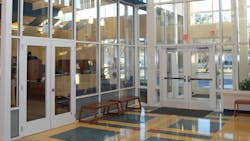When educational institutions are renovating or building new facilities, one of the many choices that must be made is whether to choose overt or subtle security measures. Nowhere is the outcome of this decision more evident in a school than at the main entrance.
From door hardware to electronic access and monitoring tools, the choices made for this space can influence the feeling of security throughout the school.
“One of the hardest things to do is balance the perception of security – do you want people to know they’re in a highly secure environment and they’re going through X-Ray machines and getting frisked at the front door, or do you want to have it without people noticing it as much,” Bill Laughlin, a vice president with Moseley Architects, says.
“It’s just a choice – do you want them to know they’re in a Big Brother state or do you just want to know that they’re safe? Finding that balance between how much you see and how much you don’t see or how much you implement and don’t implement is something that varies from project to project,” he adds.
Considering what’s at stake, administrators are often found weighing these options against what a tight budget will allow while searching for the best value for the available funds.
Building a Better Mantrap
Some choices are becoming more obvious, though. The security vestibule, also known as a mantrap, is a strategy that funnels visitors into the main office and gives administrators more control over access to the school. Incorporating this feature into the design has become the standard for new school construction and for renovation projects. This has become especially true in the wake of the 2012 Sandy Hook Elementary School tragedy.
“That’s the fundamental first step, and if you’re designing a new building, it’s easy and pretty much free to do because you’re already going to have it. You just need to configure it well,” Laughlin said.
Door access control systems have become another key ingredient of security strategies for many schools. Laughlin says he has seen an increased interest in access cards because the cards are more difficult to duplicate than traditional keys and can be easily deactivated in the event that it’s lost or stolen or when employment is terminated. Also, administrators can monitor who is in the school and when.
Laughlin says these access systems are incorporated in about 25 percent of the projects he handles.
“It’s all driven by money, because these things cost pretty significant money,” he says. “It’s a question of the value – what value does the school system see in that system?”
Hardware Choices
Another issue that many school districts are attempting to address is how the door hardware for the individual classroom and educational spaces functions. For those schools with locks that can only be activated externally, teachers are forced to lock the door from the hallway. That’s not a good option in the event of an emergency.
Fresno Unified School District in California remedied this in 2007 by retrofitting all of its classrooms with door hardware that is lockable from the inside, according to a district spokesman. That’s been the district’s standard practice ever since. Some districts that cannot afford retrofitting projects have resorted to leaving classroom doors constantly locked.
Constant Vigilance
Video surveillance at entries – both from internal and external vantage points – and high traffic areas in and around the schools is another security feature that more districts are now incorporating, Laughlin says.
Moseley Architects recently participated in a project to retrofit all of Charlotte-Mecklenburg Schools’ 110 elementary and middle schools with surveillance cameras in response to Sandy Hook and other school shootings. Three design firms participated in the project, which was completed this fall.
Laughlin says it costs about $55,000 to retrofit one elementary school with surveillance cameras. Implementing a system on the frontend, opposed to retrofitting later, can save as much as 25 to 50 percent, he adds.
Each Charlotte-Mecklenburg school has a server on site to store the video, and school officials can view the video on tablets, phones and other devices. The district also went a step further – it can feed the video into police patrol cars.
Meanwhile, surveillance cameras are being used as a kind of access control system at the University of San Francisco. The university is using a facial recognition application to help address the issue of “tailgating,” which is when one person uses his credentials to enter a building and then several people follow behind him.
“Now, when people walk as a group into a residence hall, the folks who have been enrolled as residents of the building are logged into the system as having entered and only those who are guests are called out to the attendant sitting there to be checked in,” Jason Rossi, director of the university’s security systems and One Card program, said during a recent media briefing. “And that has made an unmanageable situation manageable.
“We’ve now moved video, not just to the detection level for events that occur, but to the prevention layer because it’s acting like a card reader.”
